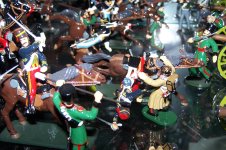T
toymodelsoldiers
Guest
Good morning.
Has anyone suffered the "loss" of one or more of their mounted Imperial soldiers due to horses that fall over too easily bending or breaking their legs? I've used clay and wax to help support them but when the weather gets warm, or there is any vibration, they tend to topple regardless. Any thoughts?
Dave.
Has anyone suffered the "loss" of one or more of their mounted Imperial soldiers due to horses that fall over too easily bending or breaking their legs? I've used clay and wax to help support them but when the weather gets warm, or there is any vibration, they tend to topple regardless. Any thoughts?
Dave.






